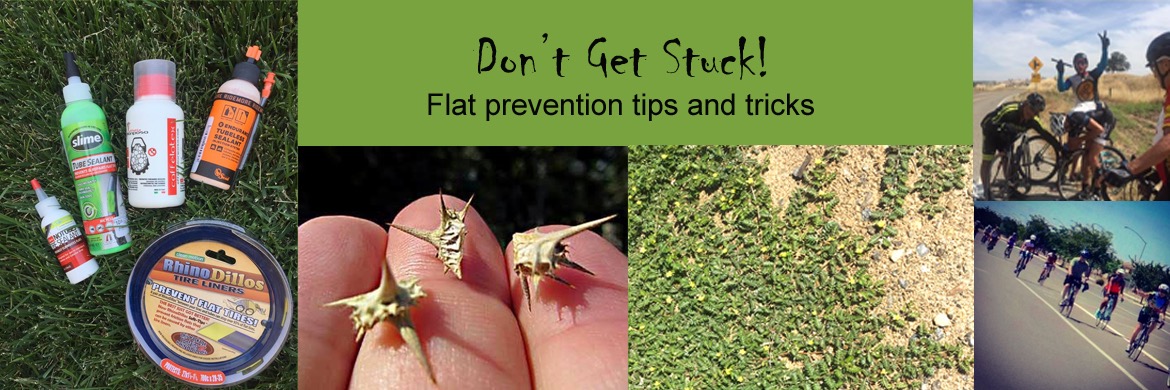Flat Prevention Tips and Tricks

Flat season is here! You may have noticed those low growing plants with the pretty yellow flowers along the side of the road on your rides; those pesky puncture vines are growing piles of tiny little daggers that will soon be lurking on the road, ready to take you out when you least expect it.
So… rather than deal with that problem on the road (as your riding buddies stand by and critique your flat changing techniques) you can do a lot to prevent them from happening at all. Here are a few of our favorite tried and true methods for preventing flats.
Seal it
The least expensive and easiest flat prevention method would be to add tire sealant to your tubes. Sealers use the tire's rotation, and the escaping air, to quickly close up small holes while you ride and often you won't even know it's happening. Some people don’t like the stuff because it can be a bit messy and adds a few extra grams of weight, but we think the trade-off is worth it! Our favorites are “Stan’s” or "Orange seal," this stuff is so good that they use it in the new tubeless tire set-ups. We have a few different brands in stock, including the original tried and true “Slime” sealant. You can let us install it for you starting at about $10.00 per wheel, depending on which product you choose.
Protect it
Steven's carries puncture-resistant tubes, which are thicker and harder to puncture than the regular version. You can make your flat prevention set-up even better by adding tire liners: strong strips of plastic that fit between your tube and tire to provide an added layer of protection from the hazards of the road. Another great way to prevent flats is to switch to puncture resistant tires; no muss, no fuss, just super tough tires. We have a variety of great ones, which usually have an inner lining made with Kevlar (the same stuff they use in bullet proof vests).
Go Tubeless
More and more riders are finding out how great it can be to avoid the hassle of changing flats by switching over to a tubeless tire system, and many newer wheels now offer a tubeless option. Going tubeless is a very effective way to bring down your number of flats and improve a bike’s overall control. With no tubes, pinch flats become a non-issue, and less air pressure is required to inflate your tire, allowing for a smoother ride and better traction while cornering and braking.
Always Be Prepared
Even the luckiest rider will eventually get a flat. Make sure you have a “survival kit” stocked up and with you on all of your rides. This consists of a bag with spare tubes, tire levers, patch kit and a CO2 inflator and/or hand pump. Some people carry a frame pump in addition to CO2, which is also a great idea in case you get multiple flats or are riding with a very unlucky group.
Come to our FREE hands-on flat changing classes! You can learn and practice how to change your own tire so you'll be ready if you ever get a flat. Call the store or check out our Facebook events for more info.
There are also a lot of things you can do to extend the life of your tires, and make sure you're always ready to roll on ride day.
Start by making sure your tires are fully inflated. Each tire has a preferred air-pressure range. You can look on the tire sidewall to find the recommended pressure for your tire, and once you know what your pressure should be, use a tire pump (many better pumps include a psi gauge) or a tire pressure gauge to check your own tire’s air pressure. We recommend adding air every time you ride. Generally, inflating the tire to the high end of the range will give you an easier rolling tire, less air will provide a more cushioned and less bumpy ride. Not only will your tires roll a lot easier, but keeping plenty of air in your tires will prevent “pinch flats,” which occur when you hit a bump and your tire compresses all the way to the rim, creating small holes in the tube.
Make it a habit to inspect your tires after your ride; it takes just a couple of minutes and can save you a lot of frustration later on. Position yourself in good lighting and take the time to slowly spin each wheel, looking for embedded objects or damage to your tire, like cracks, cuts or punctures on the sides and top. Some people like to use super glue or “shoe goo” to seal up small nicks, as long as it isn’t too large or into the protective casing, but this us usually just a temporary fix. This is also a good time to replenish your seat bag supplies, C02 and the like.
When you get your first flat on a tire examine the tread - a flat is often an indication of a worn tire. If your tires are old or worn you’ll get more flats because there’s less rubber to protect your tubes from the elements, so it’s a good idea to change your tires before they become a problem (or when you discover you have more Shoe Goo than actual tread).
While you’re riding, pay attention to where you are on the road. Most of the bad things (bits of metal, glass, etc.) collect on the shoulder of the road so it’s best to stay away from there. Scan the road for shiny things while you’re riding and avoid them whenever you can, and if you’re riding in a group make sure you alert others to the hazard.
If you still wind up riding through a bad patch, it’s a good idea to pull over and check your tire as soon as possible to see if anything has become imbedded. Flats often occur down the road a bit after you've picked up the sharp stuff so you may be able to dislodge it before it becomes a problem. Gently rotate your tire, and place your hand or a credit card on top the tread. Allow for one or 2 wheel rotations to brush items off of the tire. Wear gloves, and as tempting as it might be do NOT attempt this this while riding! It’s also a good habit to examine your tire after you stop during a ride. Often when you pull off at a rest stop or other resting place you’ll wind up rolling through a patch of puncture vines, so make sure they're gone before you roll.
If you see anything lodged in the tire, gently pry it out with a fingernail or the corner of your credit card before it gets pushed in deeper. As a side note: pulling out a deeply imbedded goathead will often be accompanied by the sound of air quickly escaping from your tube! I have made it home more than once by just leaving that nasty looking thorn firmly lodged in the tire, the worst thing that can happen is you’ll have to fix the flat later on in the ride. If you have sealer you can rest easy knowing that most holes will be plugged up before they become a problem. Go ahead and pull it out, then quickly spin the wheel to seal up the hole.
When installing a new tube
Make sure your tubes are in good shape before heading out for a ride, sitting in a seat bag for a season has been known to wear away the edges of your tube. Liberally dusting a new inner tube with talcum powder before installation makes the rubber’s surface slippery and keeps the tire and tube from sticking to each other, this reduces friction that can possibly wear a hole in the tube once installed. Steven’s has a selection of pre-talced tubes, and some people keep a quart-sized zip-lock bag with the talc in it to dust up their own tubes. Just drop the tube in and give it a good shake to coat.
Carefully run your fingers along the inside of your tire when changing your tube to feel for sharp objects that have penetrated the tread. The ultra thin wires from steel belted tires are hard to find, and are often the culprit in recurring flats and slow leaks so watch for those, too.
Examine your rim strip. If you look inside the rim you’ll see a strip of cloth or tape that encircles the entire inner rim. This is to protect your tube from objects such as the end of spokes and rough spots in the rim. If the rim strip is dislodged or damaged this can cause flats, particularly when they seem to occur (and re-occur) on the same part of the tube. CAREFULLY running your finger around the rim strip can often alert you to sharp spots you can’t see.
There are so many great options in flat prevention! Come in to the shop at Willow and Nees and we’ll tell you all about them.
